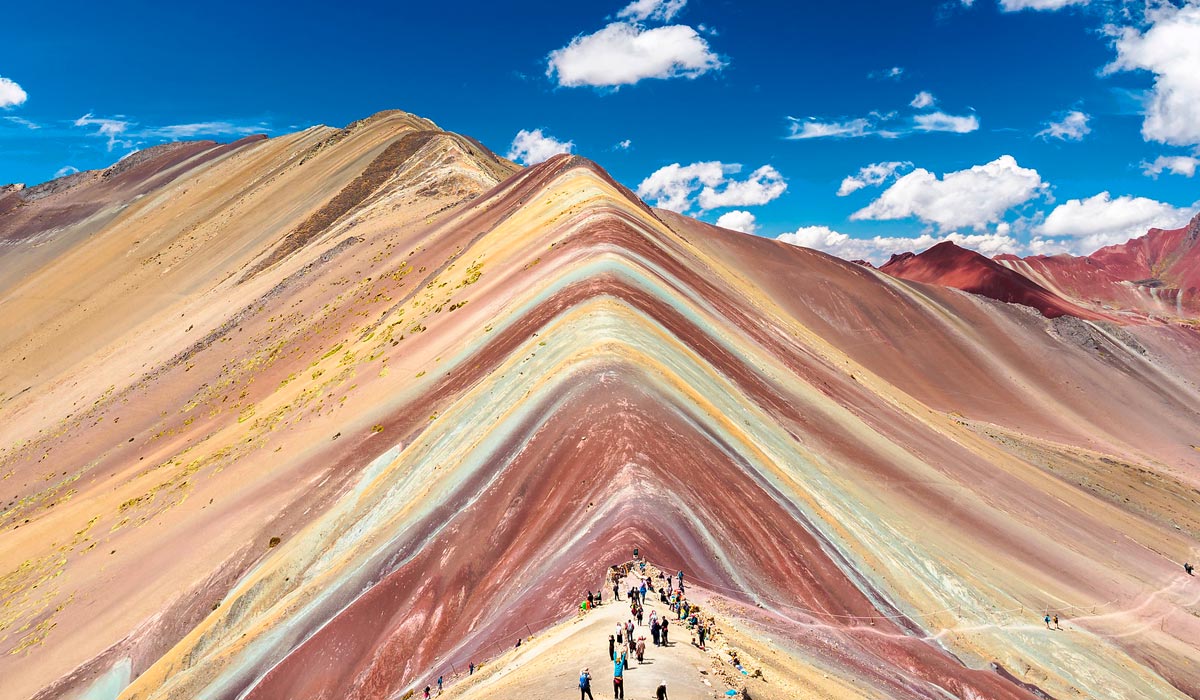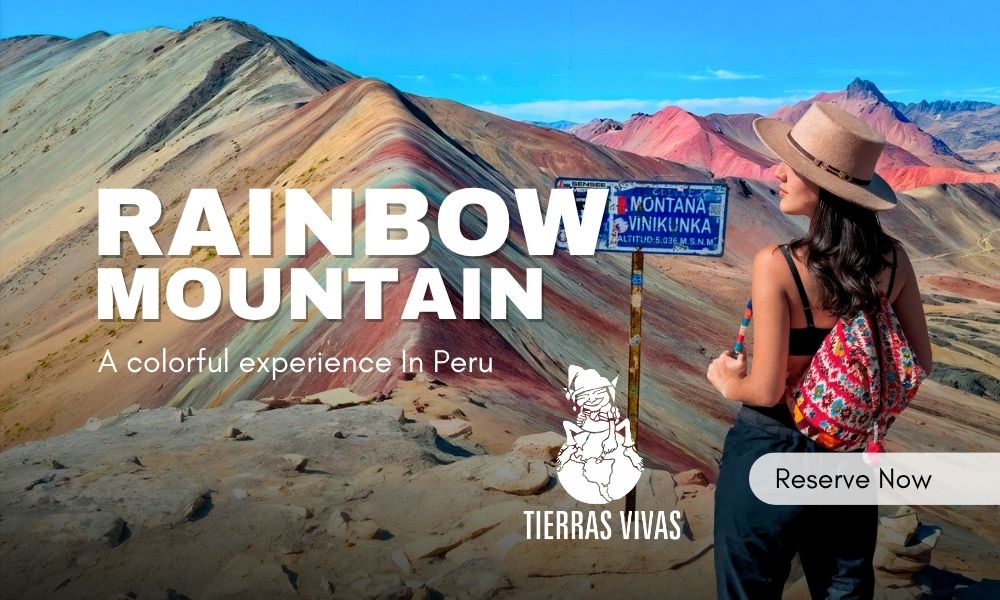The geological formation of the mountain of the 7 colors, caused many of us a question, perhaps without an answer at that moment, today we will inform you about its geological formation of this natural wonder.
The mountain of the 7 colors or Vinicunca mountain, is unique for its particular coloration, surrounded by mountains, snowy peaks, small Andean towns, above all, by an immense picturesque and colorful landscape, before informing us about the geological formation of the mountain of the 7 colors or Vinicunca mountain, we must understand how a mountain is formed.
About the Geological Formation of a Mountain
The formation of a mountain is due to the alterations of the earth's layer and the movement of tectonic plates, in these alterations the environment, the climate and other external factors have a lot to do with it. Have you ever wondered why mountains are conical? The conical shape of mountains is because ice usually forms at the top of the mountain.
Then, due to climate change, the ice melts and this causes the mountains to drain and generate streams of water that flow down to the lower area until they meet rivers or lagoons until they mix with the ocean depending on the climatic factors and because of this process the mountain wears down and takes its cone shape.
There is no doubt that mountains are a masterpiece of nature, from the top of a mountain we can appreciate everything that surrounds us and be able to enjoy it.
After learning about the causes of the formation of a mountain, it is time to find out about its geological formation of the mountain of the 7 colors and why its particular coloration.
Geological Formation of the Mountain of the 7 Colors
The geological formation of the Mountain of 7 Colors, or Vinicunca mountain, is a complex process that developed over millions of years and can be divided into three main stages:
- Marine Sedimentation: Millions of years ago, the area that the mountain now occupies was covered by water. At the bottom of this body of water, different layers of sediments (sandstone, halites, gravels, limestone) and minerals were deposited in horizontal stripes. Each layer has a different mineral composition, which explains the future variety of colors. The formation of these layers depended on the deposition period and the weight of each sediment.
- Tectonic Uplift: The second major event was the movement of tectonic plates that gave rise to the Andes Mountains. This immense tectonic force pushed and folded these sediment layers, which were originally horizaontal. This uplift process tilted the strata, giving them the diagonal and vertical orientation seen today. The mountain is, in essence, a cross-section of these sediment layers that were raised and fractured.
- Erosion and Oxidation: Finally, the colors we see today are the result of millions of years of erosion. The wind, water, and ice from the high-mountain climate wore away the rock layers that covered these strata. When exposed to the oxygen and water in the atmosphere, the minerals in each layer reacted by oxidizing, which intensified and revealed the palette of colors. The lack of vegetation at this altitude allows this geological formation to be exposed.
Coloration of the Mountain of the Seven Colors or Vinicunca Mountain
The visible colors on Vinicunca Mountain are the direct result of the mineralogical composition of the sedimentary rock layers that have been exposed by erosion. The oxidation of these minerals, upon coming into contact with oxygen and water, is what generates the distinctive palette of colors.
According to the investigation by the Landscape Office of the Decentralized Directorate of Culture of Cusco, each color stripe corresponds to a specific mineral composition. Below, the composition of each tone is detailed:
- Pink or Fuchsia Color: Caused by a mix of red clay, fangolites (mud), and arillites (sand).
- Whitish Color: Comes from quartz sandstone and marl, sedimentary rocks rich in calcium carbonate.
- Red Color: It is the result of the presence of argillites (clays) and other rocks rich in iron oxide, formed during the Tertiary period.
- Green Color: It is due to the presence of phyllites and clays rich in ferro-magnesium (a combination of iron and magnesium).
- Earthy Brown Color: Product of a fanglomerate (a rock composed of rock fragments) with magnesium, formed during the Quaternary period.
- Mustard Yellow Color: Caused by limonites or calcareous sandstones, which are rich in sulfur minerals.
It is important to note that the visual intensity of these colors can vary. Environmental factors like humidity have a significant impact; the colors usually look more saturated and accentuated after a rain, when the minerals are wet, and they change in shade as they dry with the sun and wind.
Why is it called the Mountain of the 7 Colors?
The Vinicunca Mountain, known as the "Mountain of the 7 Colors" or "Rainbow Mountain", owes its nickname to the multicoloured stripes on its slopes. These vibrant hues are due to the presence of different minerals, such as red clay, sandstone, marl and copper oxide, which were formed 65 million years ago. Thawing and erosion have revealed this natural wonder that today attracts thousands of visitors.
Geology and Cultural Significance
Vinicunca is a fascinating display of geology and natural history. Each color reveals the composition of the soil and geological processes. It also has a deep cultural and spiritual significance for local communities, connecting them to Pachamama, or Mother Earth.
Best Tours in Peru
Many are the routes that take you to Machu Picchu, but none is like the Inca Trail Tours, the most famous pedestrian path in the Americas. After flying from the capital of Perú, Lima, you will arrive in Cusco to walk for four days along a path through forests and dense fog, millenary stone steps and discovering the ruins of ancient fortifications and Inca cities, and all the time enjoying majestic views.
- Peru Adventure Holidays
- Enigmatic Peru
- Peru Full of Adventures
- Peru Luxury Travel
- Peruvian Highlands
- Peru Honeymoon Luxury
- Inca Trekkers
Inca Trail, Machu Picchu and more
- Inca Trail Tour 2026
- Inca Trail and Amazon Rainforest
- Inca Quarry Trail 4 Days
- Salkantay Trek to Machu Picchu
- Condor Sight and Salkantay Trek 5 Days
- Lima & Salkantay Trek to Machu Picchu
- Lima to Machu Picchu
- Last-Minute Tour to Machu Picchu
If you want to visit Machu Picchu, we recommend you to book your Machu Picchu Ticket in advance, so you will enjoy your Vacation in Machu Picchu without any problem.









